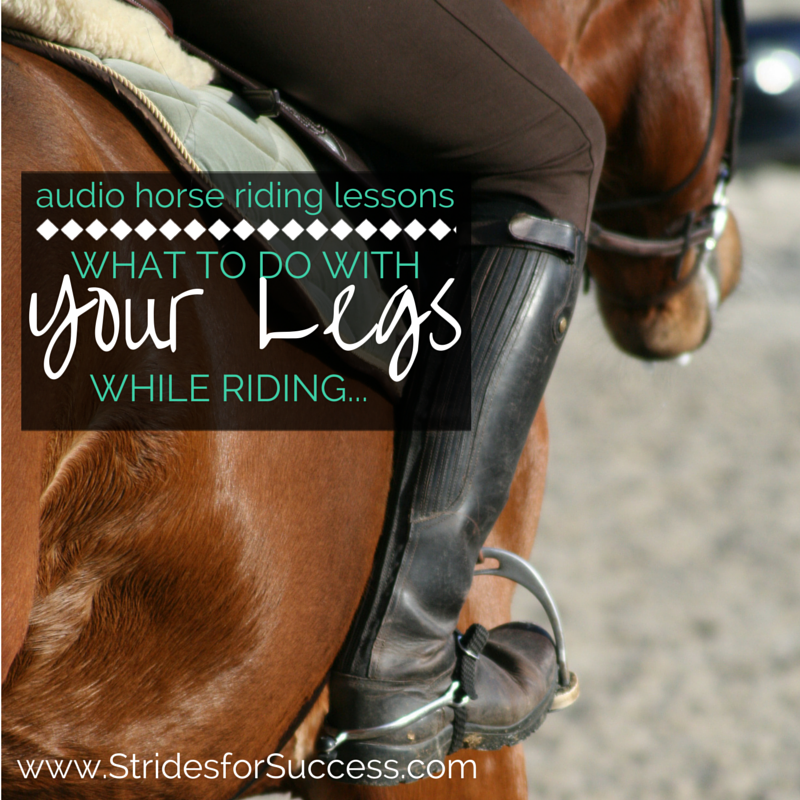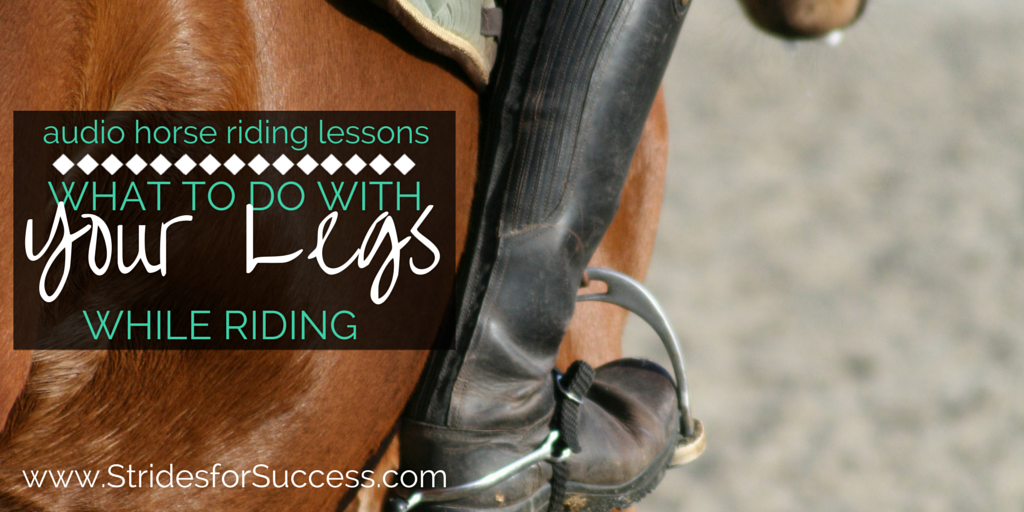What To Do With Your Legs While Riding
Do you find yourself a tad confused as to what exactly to do with your legs while you ride? Do you find that even if you know what to do, degree of pressure to use or how often to apply the aid is confusing you?
You are hearing terms such as 'Keep your leg on', 'use your leg', 'more leg', 'leg', 'soften your leg', 'support with your leg', 'back up your leg'... leg, leg, leg!!!
You can listen to the audio version of this blog post HERE on SoundCloud
You find yourself thinking back to the days when you were just happy keeping one either side of your horse!
Knowing how to apply your leg, when to apply your leg and with what pressure and regularity is something that takes lots of practice. It falls under the 'feel' category of horsemanship and riding skills. However, you can begin to improve your use of your leg right now with a few simple steps.

You leg is one of the riding aids you use to communicate with your horse. It is used to influence your horses forward and sideways movement, as well as being a regulating influence when necessary. It is also used for bending your horse and can help to contain your horse as well.
Your leg will always be present on your horses sides while you ride and should never be absent or, for whatever reason, taken away as you ride. This is often the aspect of the leg aid that confuses many riders, who initially only see the leg as a driving aid.
Before we begin, it is necessary to understand that in order to use your leg correctly, you need to have developed an independent seat while you are riding. Using your legs to balance or grip will make it impossible for you to use them to direct and ask questions of your horse.
It is also important to realize that consistency is key to mastering the leg aids, for both you and your horse.
If you wish to better your skills in the saddle, committing to being mindful and present as much as possible while you ride, particularly as to how, when and why you are using your legs, is essential.

The first aspect of beginning to use your legs as effectively as possible begins with ensuring you have a correct position in the saddle. Many times an ineffective or 'hokey pokey' leg is caused by a faulty seat. Make sure you are sitting on your seat-bones and that your legs are allowed to 'fall' down your horses sides.
You ideally want to establish the first of the two all important 'lines' of riding; the head, shoulder, hip to heel. What is important to point out here is that your hip is not your backside!!
Another way to think of this line and really know if it is true and correct is to imagine that if we could click our fingers and 'abbrakedabra' our horse away, you should technically land on your feet; not your backside and not on your face... Your feet should be underneath you at all times in the saddle!
Once you have established what is right for you, don't squeeze or tense your legs to keep them in position, this will happen naturally if your seat is correct and your hips and pelvis is open and relaxed.
Keep in mind that how your legs 'fall' depends a great deal on how you are actually put together!
In fact, the fall of your leg will depend on many different factors, the most obvious being both you and your horses conformation as well as the saddle etc. Sometimes taking a few photos of yourself in the saddle from the side and behind can help you establish if your position is indeed correct to the best of the situation.
Next thing to begin thinking about is the type of leg aid necessary for a given situation, and the degree to which it should be used. This depends a lot on the horse himself and the type of questions you are intending to ask with your legs.
Generally hotter horses respond better to a consistent pressure, while more laid back, docile horses prefer to be asked and then the aid taken away, with this action being repeated as much as necessary to achieve the desired result. One of the biggest problems faced by many riders is that both these applications of the aids almost seems to appear counter-intuitive when they initially begin working with a horse that may be similar to either of the two I just mentioned.
A hot or sensitive horse almost invites us to keep our leg off, training the rider to just apply a mere hint of an aid when they feel it is absolutely necessary... Frustratingly, this will just compound the problem and condition the horse even more that the leg is something which they must run away from. Strangely these same sensitive horses actually respond much better to a steady consistent pressure or contact from the leg, rather than short bursts of an aid here and there...
Similarly, the same is true for the more laid back horses of the world; the rider feels like they must give continuous, strong leg aids, usually to the tune of squeezing or 'pumping' and to their increasing frustration, their horse ignores them more and more... These types of horses respond better to short, concise directions that are given when needed...
Like all things worth doing, learning which aid to apply to a particular horse for the best result takes time, however it is worth the investment in the long run.
The third factor to consider when applying your leg aids is the degree of pressure that you use when applying the aid. Again, this depends on many factors, including those we have already spoken about as well as the feed your horse is receiving, if he is stabled or turned out, the work he is doing, his fitness levels, the weather conditions at that time, the riding conditions... The list is endless and as I mentioned at the beginning, this again falls under the category of developing your feel as a rider.
Luckily, all the above are things you can work on daily and become aware of every time you get into the saddle. In fact, only through increasing your mindfulness will you have any lasting success in increasing the effectiveness of your leg aids.
When it comes to actually applying your leg aids, we can broadly break the term leg aids down into three different and distinct categories. It is important to keep in mind that within these three categories, the aids can be further divided up based on degrees of pressure and regularity of occurrence.
The first is the driving aid. Terms to describe this particular aid can often be heard resounding around arenas, ringing in the ears of exhausted riders. Exasperated instructors and trainers can be seen, turning red in the face and heard roaring "Put Your Leg On!!" or "Give Him Some Leg!!" or sometimes, a short, repetitive and quite often effective 'LEG!!".
What the instructor or trainer is trying to say is 'Use your leg to create initial energy in your horse'... Hmmm, come again?!
I suggest thinking of your driving leg as turning the ignition or key in your car, or just switching on the vacuum cleaner; You ask and it responds without having to be continuously pushed in or turned. When your horse is truly listening to your aids, this will also happen when you apply this aid.
I recommend that you imagine your legs are going to wrap underneath your horses tummy and pick him up. Try lengthening your leg and then imagine that using your calves, you are going to lift his barrel up underneath you. Of course, if you do really imagine doing this, your seat and core will also begin to respond in the correct way to ask for the forward movement.
The second use of the leg aid is a more maintenance aid. Once your horse is going forward, this will be used to keep him doing so in the way you desire. This is often expressed as 'Keep Your Leg On' or 'Hold Him with Your Leg'. The biggest confusion surrounding this is that many riders turn purple in the face from the physical exertion of squeezing continuously while riding... Which of course is not what this means at all!
If you can think of your legs as being the barriers on the side of the road, except instead of keeping your horses direction on the straight and narrow (which of course your legs help to do) rather, for this aid, think of keeping the energy being created focused where you want it go.
Its like when you use the accelerator pedal in your car to go faster (your driving aid) but then once you have reached your desired speed you lighten the pressure and, while still keeping your foot on the pedal, rather maintain that speed (keeping your leg on).
The final term and leg aid that often confuses riders is the 'Relax Your Leg' or 'Take Your Leg Off'. Again, this does not literally mean what it says. In fact, if you try to lift your legs off your horses sides for any length of time you will quickly tire and begin to twist your upper body to compensate.
Rather this means that, given the situation, think of softening your leg in order to achieve a particular outcome. For example, often relaxing your outside leg while leg yielding will allow your horse to actually move to the outside, creating a 'door' of sorts for him to move through. Again, the use of this aid depends a lot on the situation and circumstances of it being applied.
As you begin to be more mindful as to how you use your legs and the reaction you receive from your horse, keep in mind that only through consistent correct practice will you eventually achieve your end goal of having almost invisible conversations with your horse, quiet and soft, to get the result you desire.
You can read the original blog post & listen to the audio lesson on this topic HERE
Happy Riding
Lorna
The Rider Marketplace
International Horse News
© 2025 Created by Barnmice Admin.
Powered by
![]()
-
Quick Links
- Horse Blogs
- Horse Forums
- Horse Videos
- Horse Photos
-
Sister Sites
- The Rider Marketplace
- The Rider
- Equine Niagara News
-
Helpful Links
- Advertise With Us
- Barnmice Tour
- Feedback
- Report an Issue
- Terms of Service
© Barnmice | Design by N. Salo
You need to be a member of Barnmice Equestrian Social Community to add comments!
Join Barnmice Equestrian Social Community